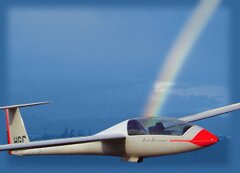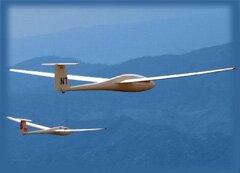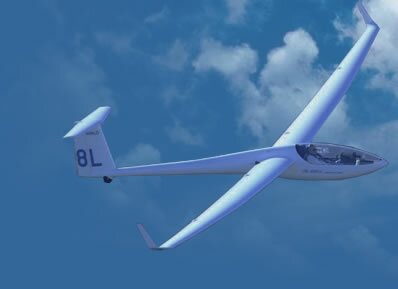|
||||

Is it a glider or a sailplane?The terms gilder and sailplane are often interchanged. We think of a "glider" as having a glide ration of less than 20:1. This means for every foot that it goes down, it goes 20 feet forward. How do gliders get into the airThe sailplane is towed into the air by a powered aircraft behind a 200 foot rope. When the pilot of the glider reaches the altitude he/she wants, they release the tow rope. The tow rope returns behind the tow plane. Usually, the glider releases in lift and works up higher. If there is no lift, the glider glides back to the airport. What happens if the wind quits?
How high will I go?By using the weather, sailplanes have flown over 1,500 miles and climbed to almost 50,000 feet. Can I fly the plane?Yes! If you are interested in flying solo, we can assist you, and provide you with the necessary training to pilot the glider yourself. If you merely want to experience the sensation of soaring, and do not want to invest the time that is required to learn to fly solo, you can enjoy one of our glider rides. Your instructor may allow you to assist in piloting the aircraft. Just indicate that you are interested in assisting! How long will I be up there?Our rides are approximately 20, 30, or 40 minutes long. Flights over 5 hours are not uncommon. Is there an age limit?For the rides, there is no minimum age. However, if a child is too young he/she will not appreciate it. We find that 4 or 5 years is when the ride becomes more appreciated. To solo, one must be 14 years old. |
||||
What is involved in learning to solo?To solo means to fly by yourself. You must be at least 14 years old and pass a brief written test to solo a glider. We can begin training at the age of 12. Although these are the only age limitations imposed on the sport, most Centers will require that you be at least the legal age of consent. A physical exam is not required, but you must have no medical problem that would prevent safe operation of the glider. Before you solo, your instructor must certify that you have learned everything necessary for safe flight and landing. |
||||
What is a private glider license?A Private Glider license, issued by the Federal Aviation Administration (FAA), allows you to carry passengers and act as pilot in command without being under the close supervision of an instructor. You must be at least 16 years old, pass a comprehensive written test and take and oral and flight test with a certified FAA examiner. When can I fly?We are open seven days a week, year round, with our hours varying slightly depending on the season. Lessons are scheduled at your convenience and are conducted one-on-one with your instructor at your own pace. Is soaring safe?Soaring can boast of being one of the safest forms of aviation. We are proud of this safety record but also know that safety doesn't "just happen" and that it must be practiced with every flight and be carefully taught to each new pilot. The best answer is that soaring is as safe as you make it. We work hard to make it as safe as it can be. Statistically, the drive to the airport contains considerably more risk than your flight. What if I have experience in power planes?
|
||||
What happens after I have my license?After you have earned your license, the sky 's the limit! You'll certainly want to introduce some of your friends to this fascinating and beautiful sport by giving them rides. Maybe you'd like to try for your Silver, Gold or Diamond badges awarded by the Soaring Society of America (SSA) for duration, distance and altitude achievements. There are also local, regional, national and international racing competitions in which you can participate. |
|


 Though there are important differences between glider and power flying, there are considerable similarities as well. If you already have a power license, obtaining a glider rating will be easy. You do not need to take another written test and you can be recommended for your license after 10 solo flights. It's worth noting that obtaining a glider rating is an acceptable substitute for a Biennial Flight Review (BFR) and that most pilots believe that glider flying improves their power flying. If you have power experience but not a license, your course of instruction will be the same as a novice with your progress being helped by your experience.
Though there are important differences between glider and power flying, there are considerable similarities as well. If you already have a power license, obtaining a glider rating will be easy. You do not need to take another written test and you can be recommended for your license after 10 solo flights. It's worth noting that obtaining a glider rating is an acceptable substitute for a Biennial Flight Review (BFR) and that most pilots believe that glider flying improves their power flying. If you have power experience but not a license, your course of instruction will be the same as a novice with your progress being helped by your experience.

